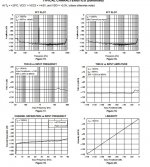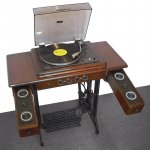Yes, I have made an attempt to understand digital theory and practice, but in evaluating the OPPO 105 in the last year or so, and owning it, I just don't find it as good as the best analog. Demian once made a really good CD player that we used to use at CES. It was pretty darn good, but vinyl was better.
John, seriously, the OPPO is a toy and so is the 'toblerone' player, no matter who designed the output stage of it.
Best,
But I don't think your numbers are correct.
http://www.ti.com/lit/ds/symlink/pcm4220.pdf
Page 11, Fig. 18 shows THD+N below –110dB for input amplitude down to –140dB ref max input of 5.6V. This –140dB is then 0.56uV. This is almost equal to two LSB for this 24bit ADC. Impressive.
And Fig. 19 shows an equally impressive linearity.
Fig 15, Fig 16 FFTs show that the THD+N is actually only N (Noise) and this THD+N is btn 0.01% to 0.1% of the –60dB signal .
George
Attachments
Perfect in "principle", and perfect in "practice". As far as one's ears are concerned. I have heard so much terrible digital sound from other systems, especially expensive ones, over the years ... I can certainly understand why many think CDs are not up to it,OK, SY prove me wrong, I would like to believe that 'digital is perfect' in principle.
Trouble is, many are obsessed with the idea that money solves everything - throw enough pricey parts and technology at the reproduction "problems", and bingo, out pops gobsmacking sound! Well, boys and girls, it ain't that way with digital - one actually has to slip the grey matter, up top, into gear to make it happen - do this the right way, and the sound can make then listening to the real thing a bit of a disappointment ...
Someone won't look through the telescope.
And this someone is always trying to portray himself as Galileo. Oh the irony.
se
And this someone is always trying to portray himself as Galileo. Oh the irony.
se
Perhaps he'll take my MIT course suggestion. Some of us don't lose an interest learning as we get older.
Perhaps he'll take my MIT course suggestion. Some of us don't lose an interest learning as we get older.
Speak for yourself. I had it all figured out years ago.
se
This myth keeps being kicked along - so long as you get rid of all the crappy analogue volume parts in the chain then there is absolutely nothing wrong with digital volume control - my first experience of high quality sound occurred using the digital volume of the CD player running the show - so I was getting convincing sound from less than 16 bits being translated! Since then, good sound has happened both from digital, and intelligent analogue attenuators - conventional analogue attentuators almost always introduce disturbing audible artifacts. These are very irritating, kill the quality stone dead, for me ...CDs are 16bit encoded. It is not advisable for (sensitive ears) to use the digital attenuator of the CDP as a volume control for to achieve a lot of attenuation.ore works with 'only' 28bits (but I am clinically deaf so, don’t count my opinion).
Tom, I did a fun exercise some years which made this misbehaviour very easy to actually hear ... because this is about voltage rails collapsing under dynamic loads. Have the test amplifier driving a dummy load, or speakers whose acoustic output is completely muffled, rendered inaudible; then, use the voltage rail as a signal to drive the line input stage of a separate, conventional audio setup - obviously, via a decent quality capacitor of sufficient rating to remove DC component - and listen. A fascinating exercise to hear just mild modulation at reasonable levels, and then when the test amplifier is given a bit of accelerator the "sound" of its voltage rail goes beserk - a grotesque cacophany, a mixture of massively distorted test amplifier audio input and bizarre gurglings, burps and carryings on ... AC hum is the very least of the noises,If one takes an oscilloscope and looks at the amplifier output, shockingly often one finds instantaneous voltage clipping on peaks.
This may be the amplifier but can also be from any part of the signal chain upstream.
About 15 years ago, QSC was going around demonstrating their amplifiers with an A/B/X switcher.
They came to the company I worked at and we set up a pair of Unity horns and about a dozen different amplifiers, including my Threshold stasis II. I had my favorite test CD’s and spent a while listening back and forth and eventually had a couple tracks where I thought best brought out a difference between the amp’s.
Then we went on to the ABX switcher. The amplifiers tended to fall into two different sounds which I could readily discern but these differences were small AND not at all what I can explain. The difference was on the decay side of transients. With the “good” amplifiers, the decay was smooth like an asymptotic curve but the “other” sound was where the decay became granular or like it has steps in the amplitude or something???.
The really unexpected thing was relevant to the post though, with my stasis compared to the good pro amps, at a level not higher than I had used in my living room, my stasis began to sound “less dynamic”. On the LED indicator the peaks were in the -20 to -10dB range so this was weird and weird they were undetectable as different amps up to that point.
An oscilloscope on the Threshold output showed that around the level where the dynamics were altered, what I saw was instantaneous voltage clipping.
Everyone knows what “clipping” sounds like BUT this form of clipping you can’t hear as a “flaw” because it may only exist for one or two cycles, VERY SHORT, not like icky clipping and I could only hear it by switching between “with and without” and the “sound was simply being less dynamic.
Since then, in larger systems, I have found dynamic limiting due to gain structure being off is also a common issue and the best, maybe only easy way to find out is with an oscilloscope playing dynamic music.
Sew gooood ...
Page 11, Fig. 18 shows THD+N below –110dB for input amplitude down to –140dB ref max input of 5.6V. This –140dB is then 0.56uV. This is almost equal to two LSB for this 24bit ADC. Impressive.
And Fig. 19 shows an equally impressive linearity.
Fig 15, Fig 16 FFTs show that the THD+N is actually only N (Noise) and this THD+N is btn 0.01% to 0.1% of the –60dB signal .
George
Looks like 24 bit playback system would be a step forward. Nit-picking..... specmanship at work... the dynamic range is at 0FS not -1. So the 'typical' value is actually a few dB's lower than -108. Just one of those little fudges manfr do to look equal/competitive. Its isnt much but they try to slip it by.
After the smoke clears and 24 bit is the better route to go.... dropping CD becomes the next step. I dont know what I am going to do with my 11,000 blues songs on 1100 CD's. Probably the same thing I did with LP's, tapes and cassettes (and Laser disk, VHS). Or, I'll keep a CD player around for a legacy music source.
Long live the CD!
Actually, as soon as I heard the 24 bit downloads and no disk player needed.... and I had got me a very good DAC, I havent bought a lesser sounding CD disk since.
My only remaining question is.... with very low cost 32/64 bit DSP here now and recordings done at those higher bits.... how many years until we have 32 bit HiRes downloads and I have a third legacy gear/software to let go of.
However, I wont have a wall of records or CD's and DVD's stored in physical space anymore. I've also stopped buying HD/3D movies on disk with the streaming HD downloads available to me. Did buy the UHD video Monitor (TV) because it looks much better.
THx-RNMarsh
Last edited:
Tom, I did a fun exercise some years which made this misbehaviour very easy to actually hear ... because this is about voltage rails collapsing under dynamic loads. Have the test amplifier driving a dummy load, or speakers whose acoustic output is completely muffled, rendered inaudible; then, use the voltage rail as a signal to drive the line input stage of a separate, conventional audio setup - obviously, via a decent quality capacitor of sufficient rating to remove DC component - and listen. A fascinating exercise to hear just mild modulation at reasonable levels, and then when the test amplifier is given a bit of accelerator the "sound" of its voltage rail goes beserk - a grotesque cacophany, a mixture of massively distorted test amplifier audio input and bizarre gurglings, burps and carryings on ... AC hum is the very least of the noises,.
I had an engineer who worked with me who took it one further and monitored the ac power lines of a power amp while playing music. Music is there also !!
Just thought I'd throw that in the mix to think about. Messy business, this audio.
THx-RNMarsh
Well, the obvious thing to do is for someone to get hold of those 1100 CDs, upsample them on the sly to "HiRes quality" and then sell them back to you, as premium downloads. You'll be raving about the sound ... and everyone will be happy ....
I'm sure that is the plan of someone's. But, I am sleeping with one eye open for it.
Fortunately, with a little effort, there is music out there i like and dont have yet.
THx-RNMarsh
I'm sure that is the plan of someone's.
Or think up something even smarter.
http://www.rintelen.ch/konzept_und_text/download.php?file2download=Digitizing_LPs.pdf
- Status
- Not open for further replies.
- Home
- Member Areas
- The Lounge
- John Curl's Blowtorch preamplifier part II

